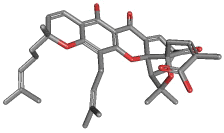|
GAMBOGIC ACID |
| Synonyms. Gambogic acid; B''-Guttiferin; beta-Guttiferin; Cambogic acid; (Z)-4-((1S,3aR,5S,11R, 14aS)- 8-Hydroxy-2,2,11-trimethyl-13-(3-methylbut-2-en-1-yl) -11-(4-methylpent-3-en- 1-yl)-4,7-dioxo- 2,3a,4,5,7,11 -hexahydro-1H-1,5-methanofuro[3,2-g]pyrano [3,2-b]xanthen-3a-yl) -2-methylbut-2-enoic acid; 1,5-Methano-1H,3H,11H-furo(3,4-g)pyrano(3,2-b)xanthene-1-crotonic acid; Beta-Guttilactone; Guttatic acid; Guttic acid; |
| PRODUCT IDENTIFICATION | |
|
CAS RN |
2752-65-0 |
|
EINECS RN |
|
|
FORMULA |
C38H44O8 |
|
MOLE WEIGHT |
628.75 |
|
H.S CODE |
2918.99.3000 |
|
SMILES |
O=C1/C4=C/[C@H]6C(=O)[C@@]5(OC([C@@H]([C@]45Oc3c1c(O)c 2\C=C/[C@@](Oc2c3C\C=C(/C)C)(C)CC\C=C(/C)C)C6)(C)C)C/C =C(\C(=O)O)C |
|
CLASSIFICATION |
Xanthonoid |
|
EXTRA NOTES |
Biochem/physiol Actions:Gambogic acid acts as a caspase activator and apoptosis inducer, which causes an irreversible arrest in the G2/M phase of the cell cycle. sigmaaldrich |
|
|
| PHYSICAL AND CHEMICAL PROPERTIES | |
|
PHYSICAL STATE. |
Orange solid |
|
MELTING POINT |
|
|
BOILING POINT |
|
|
DENSITY |
1.29 |
|
SOLUBILITY IN WATER |
|
| SOLVENT SOLUBILITY |
Soluble in DMSO, ethanol |
|
VAPOR DENSITY |
|
|
log P(octanol-water) |
|
|
VAPOR PRESSURE |
|
|
AUTOIGNITION TEMP |
|
| pK |
|
|
REFRACTIVE INDEX |
|
|
FLASH POINT |
|
|
|
| STABILITY AND REACTIVITY | |
| STABILITY | Stable under normal conditions. |
|
INCOMPATIBLE MATERIALS |
Strong oxidizing agents |
| POLYMERIZATION |
Has not been reported |
|
NFPA RATINGS |
Health: 1, Flammability: 0, Reactivity: 0 |
|
|
| EXTERNAL LINKS & GENERAL DESCRIPTION |
|
USA.gov - Gambogic acid Wikipedia Linking - Gambogic acid Google Scholar Search - Gambogic acid U.S. National Library of Medicine - Gambogic acid PubChem Compound Summary - Gambogic acid KEGG (Kyoto Encyclopedia of Genes and Genomes) - Gambogic acid ChEBI (http://www.ebi.ac.uk/chebi/) - Gambogic acid NCBI (http://www.ncbi.nlm.nih.gov/) - Gambogic acid |
|
|
| SALES SPECIFICATION | |
|
APPEARANCE |
Orange solid |
|
ASSAY |
98% min |
|
OPTICAL ACTIVITY |
-685° (methanol) |
|
LOSS ON DRYING |
0.5% max |
|
|
| TRANSPORT & REGULATORY INFORMATION | |
|
UN NO. |
2811 |
| HAZARD CLASS |
6.1 |
| PACKING GROUP | III |
|
|
| SAFETY INFORMATION | |
|
HAZARD OVERVIEW |
GHS (Globally Harmonised System) Classification: Acute toxicity (Oral). Skin irritation. Eye irritation. Specific target organ toxicity - single exposure. Hazard statements: Causes skin irritation. Causes serious eye irritation. May cause respiratory irritation. |
| SIGNAL WORD | Danger |
|
PICTOGRAMS |
|
|
HAZARD STATEMENTS |
H301 Toxic if swallowed. |
|
PRECAUTIONARY STATEMENTS |
P261 Avoid breathing dust/ fume/ gas/ mist/ vapours/ spray. |
| EC DIRECTIVES |
|
| HAZARD CODES |
|
|
RISK PHRASES |
25:Toxic if swallowed |
|
SAFETY PHRASES |
26:In case of contact with eyes, rinse immediately with plenty of water and seek medical advice |
|
|
| PACKING |
|
Preserve in light-resistant and well-closed containers |
|
|
| PRICE INFORMATION |
|
|

